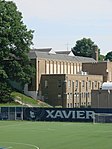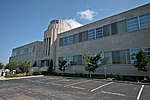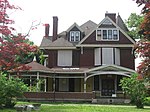Corcoran Stadium
Corcoran Stadium was a stadium in Cincinnati, Ohio. It hosted the Xavier University Musketeers football team until the school dropped football for financial reasons in 1973. The stadium held 15,000 people when it opened on November 23, 1929. The stadium was finally razed in 1988 after attempts to revive the program in the NCAA's Division III failed. Corcoran Stadium also played host to one NFL game on October 7, 1934 when the Cincinnati Reds (NFL) took on the Chicago Cardinals. The Reds lost the match by a score of 13-0 before 2,500 Reds fans. Corcoran Stadium can be seen in the 1946 movie The Best Years of Our Lives as "Jackson High Football Stadium". A few seconds later Walnut Hills High School with its distinctive dome and football field can be seen along with the downtown Cincinnati skyline (Carew Tower and PNC Tower) in the background.
Excerpt from the Wikipedia article Corcoran Stadium (License: CC BY-SA 3.0, Authors).Corcoran Stadium
Victory Parkway, Cincinnati North Avondale
Geographical coordinates (GPS) Address Nearby Places Show on map
Geographical coordinates (GPS)
| Latitude | Longitude |
|---|---|
| N 39.148542 ° | E -84.478504 ° |
Address
Corcoran Field
Victory Parkway
45229 Cincinnati, North Avondale
Ohio, United States
Open on Google Maps









